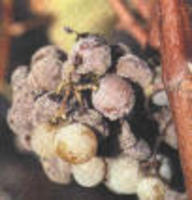
Botrytis cinerea genome project

Grapevine infection
Ascomycete Botrytis cinerea (asexual stage of the teleomorph Botryotinia fuckeliana) is a necrotrophic fungus that causes grey mould disease on a very broad host range (more than 200 plant species) and inflicts serious crop losses worldwide.
Known as polyphageous, B. cinerea is actually a species complex in which distinct populations could be adapted to different hosts (Choquer et al, 2007) . It is also the cause of the famous noble rot that imparts a characteristic flavour to sweet wines.
In 2005, the international consortium "Botrytis & Sclerotinia genome project" led by M.H. Lebrun (INRA-Bioger) was initiated to support the sequencing and genome annotation of these two closely related necrotrophic and polyphageous fungi (Fillinger et al, 2007) . These are the two first leotiomycetes to be fully sequenced. B. cinerea strain T4 was sequenced with a 10X genome coverage at the French National Sequencing Center, Genoscope while S. sclerotiorum was sequenced with a 8X coverage at the BROAD institute . In parallel, the 4X sequence of the B. cinerea B05-10 strain from Syngenta was also released by the BROAD institute. Based on these data, the consortium conducts an expertise of the structural and functional annotation of the resulting predicted genes.
Objectives
- Genome sequencing (2006) by Genoscope (40 Mb, 10x coverage, 118 supercontigs)
- cDNA sequencing 80000 ESTs (2007) Genoscope / Bayer Cropscience / Chili
- Structural annotation
- Gene prediction
- Transposable element annotation
- Functional annotation
- Manual curation
- Transcriptomics
- Comparative genomics
Results
Botrytis / Sclerotinia genome project publication
Botrytis cinerea T4 Genome was sequenced and assembled by the Genoscope (39.5 Mb, 118 supercontigs, 2281 contigs, 10X coverage) and annotated at URGI. Features mapped on the genome and available in GnpGenome :
- A GnpGenome instance has been set up for Botrytis T4 Structural annotation :
GnpGenome
.
- The gene prediction pipeline has been processed through ab initio gene finding softwares and similarity methods. All results have been then gathered and processed by Eugene to predict 16360 gene models. 14250 gene models have been predicted (94% have at least an evidence: expression, domain/motif, Bi-Directional Best Hit with a related genome Sclerotinia sclerotiorum), other 2110 genes are small (length < 100aa) without evidence.
- Uniprot and a Fungal protein database (containing proteins from 30 fungal genomes)
- 83000 ESTs (9667 unisequences) from 14 B. cinerea cDNA libraries
- 70000 ESTs from S. sclerotiorum ( Broad Institute )
- Genes from B. cinerea (B05.10 isolate) and S. sclerotiorum (Broad Institute)
- Genomes of B. cinerea (B05.10 isolate) and S. sclerotiorum (Broad Institute)
- Repeats from RepBase
- Tandem repeats found by TRF
- The automated functional annotation pipeline has been performed on the 16360 gene models predicted by EuGene. Results are available in a functional annotation database dedicated to Botrytis cinerea T4, B05.10 and Sclerotinia sclerotiorum: Genome Report System .
- More details in Sequences & Databases and publications
Creation date: 06 Apr 2010
 eZ Publish
eZ PublishPublication supervisor: A-F. Adam-Blondon
Read Credits & General Terms of Use
Read How to cite








